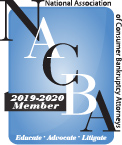Homeowners will encounter an unusual accounting practice in the Chapter 13 bankruptcy process.
This is the practice of mortgage servicers maintaining two separate sets of books while homeowners are in the Chapter 13 process.
First, it is important to note that a Chapter 13 bankruptcy is a reorganization bankruptcy, in which you prioritize the payment of certain debts over other debts.
One of the types of debts that may be paid ahead of others in a Chapter 13 is a secured mortgage payment.
In the case of a mortgage arrearage, a Chapter 13 plan may be designed and filed to cure those arrears and bring the house payment current over a period of 3 to 5 years.
In addition, the Chapter 13 plan may also provide that the mortgage payment will either be paid by the homeowner-debtor directly or by the Chapter 13 Trustee assigned to the case.
It is the job of the Chapter 13 Trustee to receive the monthly Chapter 13 plan payment from the debtor who filed the case and to disburse that money to creditors—in the priority order outlined by the Chapter 13 plan and the Bankruptcy Code.
The bankruptcy process does not, however, mean that the mortgage servicer handling the accounts payable and receivable for the mortgage holder is not still keeping books outside of the bankruptcy process on the back-end.
After all, for a variety of reasons, a certain number of people who file Chapter 13 bankruptcies do not complete the bankruptcy process and do not receive a bankruptcy discharge.
They exit the Chapter 13 process with a remaining mortgage balance and owing all accrued fees, interest, and back-payments.
During the Chapter 13 bankruptcy process, the mortgage servicer receives payments for the mortgage arrearage—but also receives payments for the ongoing monthly mortgage installments.
The company will thus maintain a system of record or accounting software that tracks the homeowner’s payments prior to bankruptcy and which continues on after the filing of and during the bankruptcy case.
However, when a customer files Chapter 13 bankruptcy, they also then maintain an .xls spreadsheet that tracks the mortgage payments as they are received from the Chapter 13 Trustee (or directly from the debtor, if the mortgage payment is not being paid through the Chapter 13 Plan).
This dual accounting process leaves a lot of room for error.
In response, Congress enacted Bankruptcy Rule 3002.1.
This Bankruptcy Rule requires mortgage companies to disclose any fees or charges, late charges, or attorney’s fees that are charged in the case.
Such fees can include fees for preparation of proof of claim that is filed in the case, attorney plan review, broker price opinions, in which the mortgage servicer sends someone out to drive past the house and—ensure that it still exists, apparently.
All of these fees have to be disclosed within 6 months of the fee being incurred. That allows the debtor or borrower and their lawyer to know what fees are being assessed.
If the fees are unreasonably large (and what is “unreasonable” will vary from Federal jurisdiction to jurisdiction), or the servicer is charging for a new broker price opinion for unnecessary drive-bys of the property every other week, your bankruptcy attorney will have the opportunity to object to the fees and obtain a ruling for or against from the judge in your case.
What if the fees are not disclosed at all?
You can be assured that, on the system of record maintained by the mortgage servicer, that fee was included as incurred.
It may, however, not also appear on that separate Chapter 13 .xls spreadsheet.
What happens then?
The debtor has done everything he or she is supposed to do in the Chapter 13 process. Every plan payment is made, every tax return is turned over, all changes in income are properly disclosed to the Trustee—and the mortgage arrearage is paid in full.
The discharge is granted. The case is closed.
However, the mortgage servicer may not have properly scrubbed their records to ensure that fees not properly disclosed to the Bankruptcy Court—those which appear in their ongoing accounting system of record but which do not appear on that .xls spreadsheet—are removed.
They should not appear on a mortgage statement received by the now-former debtor after the bankruptcy case.
The problem is compounded when mortgage servicing rights are transferred from one entity to another.
This may have happened 1 day after the filing of the bankruptcy.
It may happen when the bankruptcy concludes. It can happen whenever the Master Trust Servicer working for the mortgage holder wants it to.
You may start your bankruptcy process with Mortgage Company A and then finish it with Mortgage Company B. Then, one month later, you end up with Mortgage Company C.
When you finish your bankruptcy case, all of these entities should be auditing their records to ensure that these fees and charges that weren’t properly disclosed don’t end up on your file.
However, it is common that they either do not. It is common that the accounting records of one servicer are either not wholly transferred along with the servicing obligation to Company B or were poorly maintained to begin with.
What do you do?
If you have completed your bankruptcy case, and fees are showing up on your mortgage statement that seem improper, contact your bankruptcy lawyer, or speak to someone who can properly advise you as to whether you really owe them.
It is possible that you do owe them. Your mortgage contract almost certainly allows fees to be charged in certain situations. If the fee was not unreasonable per local practice in your jurisdiction and was properly disclosed, it may be legitimate.
However, there is no reason to not question a fee that appears on your mortgage statements after you complete you bankruptcy case that you have reason to believe it is improper.
If you have mortgage fees or post-bankruptcy accounting concerns, contact us to discuss the issue.





